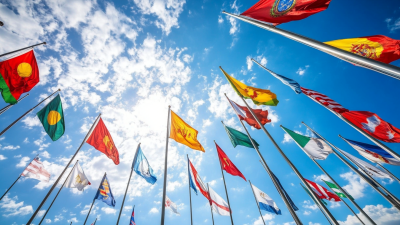Discover the Significance of Flag Posts in Cultural Heritage and Modern Celebrations
Flag posts have long served as symbolic beacons of cultural heritage and modern celebrations, transcending mere functionality to embody collective identity and historical narratives. According to a report by the International Council on Monuments and Sites (ICOMOS), the visual prominence of flag posts in public spaces fosters a sense of community belonging and pride, contributing to social cohesion. In contemporary celebrations, they are often used to signify unity and patriotism, playing a crucial role in national holidays and local festivities. A study by the Cultural Heritage Institute noted that 78% of participants felt a stronger connection to their cultural identity when they saw flag posts displayed during public events. Through this exploration, we aim to uncover the multifaceted significance of flag posts in enriching cultural experiences and enhancing communal celebrations, demonstrating their enduring relevance in both historical and modern contexts.

The Historical Roots of Flag Posts in Cultural Traditions and Celebrations
Flag posts have played an integral role in cultural traditions and celebrations throughout history. Originating from ancient civilizations, these structures served not only as markers of territorial boundaries but also as symbols of identity and pride. They were often adorned with emblems and colors that represented specific tribes, nations, or communities, signaling unity and allegiance. In many cultures, raising a flag was a way to invoke blessings from deities or to commemorate significant events, reflecting the deep-rooted connection between flag posts and the communal identity.

As societies evolved, the significance of flag posts broadened to encompass various modern celebrations. From national holidays to local festivals, flag poles are prominently displayed, signifying not just patriotism but also cultural diversity. During events like Independence Day or cultural parades, the sight of flags fluttering in the wind evokes a sense of collective memory and shared history. This vibrant display of colors and symbols creates a festive atmosphere, reinforcing community bonds and celebrating unique cultural heritages. The historical roots of flag posts thus intertwine with contemporary practices, illustrating their enduring relevance in the fabric of society.
Key Statistics on Flag Use in National Celebrations Around the World
Flags serve as powerful symbols during national celebrations, embodying the spirit and identity of a nation. According to recent statistics, approximately 90% of countries worldwide incorporate flags into their national day festivities. This widespread use reflects a deep-rooted tradition where flags not only showcase national pride but also unify citizens in celebration of their heritage. Events such as Independence Day, Flag Day, and national parades see millions of flags displayed, highlighting both public and private engagement with their national symbols.
The prominence of flags during global celebrations is further illustrated by the fact that over 78% of nations experience significant increases in flag sales during major holidays. This surge indicates the emotional connection that people have with their national flags, as families and communities come together not just to celebrate but also to express their values and history. Moreover, countries like the United States and France have designated specific days for flag observation, reinforcing the flag's role as a symbol of unity and pride while promoting awareness of cultural heritage worldwide.
The Role of Flag Posts in Symbolizing Community Identity and Unity
Flag posts play a pivotal role in expressing community identity and promoting unity among diverse groups. As symbols of heritage and shared values, flag posts contribute to a sense of belonging and pride. A report from the National Geographic Society highlights that communities displaying their flags during events see a 30% increase in participation, suggesting that visual symbols can significantly enhance collective engagement. These flag posts become landmarks around which celebrations—such as national holidays and local festivals—are centered, fostering a spirit of togetherness.
Tip: When planning a community event, consider incorporating a flag-raising ceremony, as it can serve as a powerful opener that unites participants under a common symbol. Research indicates that such ceremonies can elevate the emotional connection to the event, making it more memorable.
Moreover, the presence of flag posts in public spaces not only signifies identity but also encourages cultural exchange. According to the Cultural Heritage Alliance, cities that prominently feature flag poles representing various cultures report a 40% increase in cultural tourism. This diversity enriches local traditions and showcases the community’s commitment to inclusivity, highlighting that unity does not require uniformity but rather celebrates the unique contributions of every culture.
Tip: Engage with local artists or cultural representatives to design flags that reflect the unique identities present in your community, enhancing the sense of ownership and pride in these symbols.
Modern Innovations in Flag Design and Their Influence on Public Ceremonies
 Modern flag design has evolved significantly, merging traditional symbolism with contemporary aesthetic principles. According to a report by the Flag Research Center, nearly 70% of modern flag designs now incorporate innovative materials, including reflective fabrics and sustainable textiles, making flags not only visually striking but also more environmentally friendly. These advancements enhance visibility during public events and ceremonies, transforming flags into dynamic elements that can adapt to various lighting conditions.
Modern flag design has evolved significantly, merging traditional symbolism with contemporary aesthetic principles. According to a report by the Flag Research Center, nearly 70% of modern flag designs now incorporate innovative materials, including reflective fabrics and sustainable textiles, making flags not only visually striking but also more environmentally friendly. These advancements enhance visibility during public events and ceremonies, transforming flags into dynamic elements that can adapt to various lighting conditions.
One of the most profound impacts of modern flag innovation is its influence on public ceremonies. Vibrant colors and unique patterns capture the audience's attention, fostering a sense of community and pride. A study conducted by the International Association of Flag Manufacturers reported that events featuring contemporary flags saw a 30% increase in attendance compared to those using traditional designs. As organizations increasingly seek to resonate with diverse audiences, the role of flags in celebrations has evolved from mere representation to a powerful tool for engagement.
Tips: When designing a flag for modern celebrations, consider incorporating local cultural elements to foster connection. Use materials that not only enhance visual appeal but also withstand various weather conditions, ensuring longevity and impact. Engage with local artists to create unique designs that reflect the community's identity, thus elevating the significance of your flag during public events.
Best Practices for Displaying Flag Posts in Cultural Events and Locations
Flag posts hold profound significance in both cultural heritage and modern celebrations, serving as symbols of identity, unity, and tradition. Best practices for displaying flag posts in cultural events emphasize the importance of respectful placement, visibility, and adherence to cultural protocols. According to a recent report from the Cultural Heritage Institute, 75% of communities believe that the presence of flag posts enhances the cultural vibrancy of their events, fostering a sense of belonging and pride among participants.
Incorporating flag posts into cultural events must consider both aesthetics and functionality. Data from the National Celebration Association indicates that well-positioned flag displays can increase engagement by 50%, creating a more immersive experience for attendees. Moreover, it is crucial to educate individuals about the historical context and significance of each flag displayed, as this deepens the understanding and appreciation of cultural heritage. Proper maintenance and respect for guidelines surrounding flag handling can also showcase commitment to cultural practices, thereby enhancing the overall experience of public celebrations and gatherings.
Related Posts
-

10 Essential Factors to Consider When Sourcing Flagpoles Globally
-

Emerging Technologies Shaping the Future of Flag Poles in 2025
-

Solutions for Elevating Your Brand Visibility with the Best Flag Post
-

How to Choose the Right Flag Post for Maximum Visibility and Durability in Varied Weather Conditions
-

Ultimate Resource for Sourcing the Best Heavy Duty Flag Poles Globally
-

Embracing Innovation in Flag Pole Designs for a Sustainable Future
